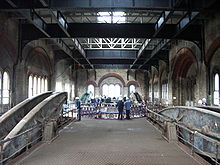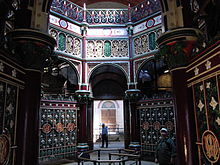- Crossness Pumping Station
-
Crossness Pumping Station was a sewage pumping station designed by engineer Sir Joseph Bazalgette and architect Charles Henry Driver. It was constructed between 1859 and 1865 as part of his redevelopment of the London sewerage system. It is located at Crossness, southeast London, England, at the eastern end of the Southern Outfall Sewer.
The sewage was pumped up into a 27-million-imperial-gallon (120,000 m3) reservoir, and was released into the Thames during the ebbing tide[1].
The station contains the four original pumping engines, which are thought to be the largest remaining rotative beam engines in the world, with 52 ton flywheels and 47 ton beams. The engines are named: Prince Consort, Victoria, Albert Edward, and Alexandra. Although the engines are original, they are not in their original 1864 configuration as all four engines were converted from single cylinder to the current triple expansion operation in 1901 and 1902. Prince Consort was returned to steam in 2003 and now runs on Trust Open Days. The other engines are not in working order, although work has begun on the restoration of Victoria.
It is adjacent to Erith Marshes, a grazing marsh, the northern part of which is designated as Crossness Nature Reserve.[2] This provides a valuable habitat for creatures ranging from moths to small amphibians and water voles.
Contents
History
The Crossness Pumping Station was officially opened by Edward, Prince of Wales in April 1865 and the Beam Engine House is now a Grade I listed building[3] featuring spectacular ornamental cast ironwork – it has been described as "A masterpiece of engineering – a Victorian cathedral of ironwork" by Nikolaus Pevsner.
The pumping station was decommisioned in the 1950s, and it was not considered economic to dismantle the engines as the cost of doing so far exceeded any scrap value. The more valuable metal items (made from brass) such as the engine oilers, much pipework and even the handrails from the stairs were removed. The remaining building and engines were left to suffer considerable vandalism and decay.
Today the pumping station is managed by the Crossness Engines Trust, a registered charity set up in 1987 to oversee the restoration project. It is on the Buildings at Risk Register,[4]
Restoration
Prince Consort was thought to be the last engine to run, in 1953, and it is this engine on which the restoration activity has concentrated. After some fifteen years of effort the engine is now working again and is run on the open days organised by the Trust.
When the buildings were abandoned, the pumps and culverts below the Beam Engine House were filled with sand to reduce the risks from methane. This has meant that some 100 tons of this sand has had to be excavated from around and underneath the pumps before there was any hope of moving the beam and flywheel. Further, there was a considerable ingress of rain water which has resulted in serious rusting of the engine parts.
Museum
Having received funding from the Heritage Lottery Fund and other benefactors, work is currently progressing at the site to build an access road, protect the buildings and to develop a museum focusing on the Great Stink of 1858 and the role of Crossness in improving London's sewerage system. Re-opening to the public is planned for 2011.[5]
The building was used extensively for the 2011 BBC production of Michel Faber's The Crimson Petal and the White.[6]
See also
- Abbey Mills Pumping Stations – the equivalent pumping station for the Northern Outfall Sewer, the "twin" of Crossness
- Markfield Beam Engine and Museum
References
- ^ The Crossnees Engines published by The Crossness Engines Trust
- ^ Erith Marshes at London WildWeb
- ^ Details from listed building database (198633) - pumping house - grade I. Images of England. English Heritage.
- ^ Buildings at Risk Register: Crossness
- ^ Official website - 11 April 2011
- ^ "Film London - April 2011 - Crossness Engines Trust". Film London. http://filmlondon.org.uk/filming_in_london/locations_crew_facilities/locations/location_of_the_month_2011/april2011. Retrieved 2011-04-29. "Crossness Pumping Station, part of The Crossness Engines Trust, was sourced as an excellent authentic Victorian location which was also flexible. It not only acted as the interior and exterior of William Rackham's cosmetic factory, but also doubled as the interior of a London train station."
External links
- Crossness Pumping Station - official website
- Details from listed building database (198747) - south east workshops - Grade II. Images of England. English Heritage.
- Details from listed building database (432966) - south west workshops - Grade II. Images of England. English Heritage.
- Profile from Hidden London
- Pictures of Crossness Pumping Station
- Video of Prince Consort engine working
- Video of Prince Consort Corliss valve gear
Coordinates: 51°30′32.6″N 00°08′18″E / 51.509056°N 0.13833°E
London Borough of Bexley Districts Abbey Wood · Albany Park · Barnehurst · Barnes Cray · Belvedere · Bexley · Bexleyheath · Blackfen · Crayford · Crook Log · Crossness · East Wickham · Erith · Falconwood · Foots Cray · Lamorbey · Lessness Heath · Longlands · North Cray · Northumberland Heath · Sidcup · Slade Green · Thamesmead · Upton · Welling · West Heath
Attractions Hall Place and Gardens · Red House (NT) · Danson House · Crossness Pumping Station · Foots Cray MeadowsParks and open spaces Lesnes Abbey WoodsConstituencies Other topics People · Public art · SchoolsCategories:- Buildings on the Buildings at Risk Register
- Buildings and structures completed in 1865
- 1865 establishments
- London water infrastructure
- Preserved beam engines
- Preserved stationary steam engines
- Grade I listed buildings in London
- Grade II listed buildings in London
- Grade I listed industrial buildings
- Buildings and structures in Bexley
- Museums in Bexley
- Proposed museums in the United Kingdom
- Steam museums in the United Kingdom
- Thames Water
- Pumping stations
- Charities based in London
Wikimedia Foundation. 2010.



